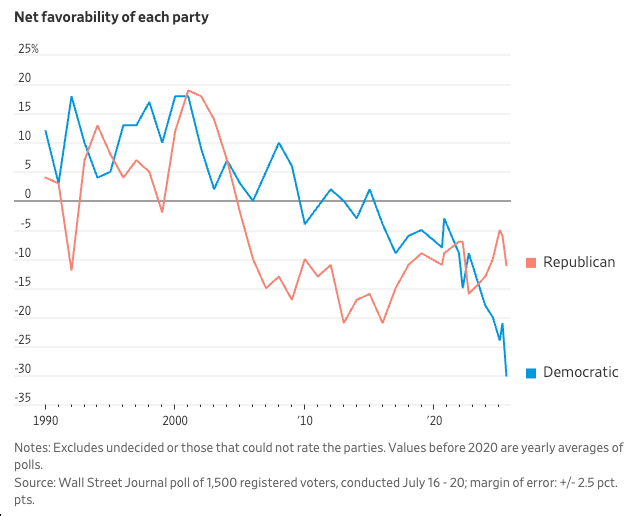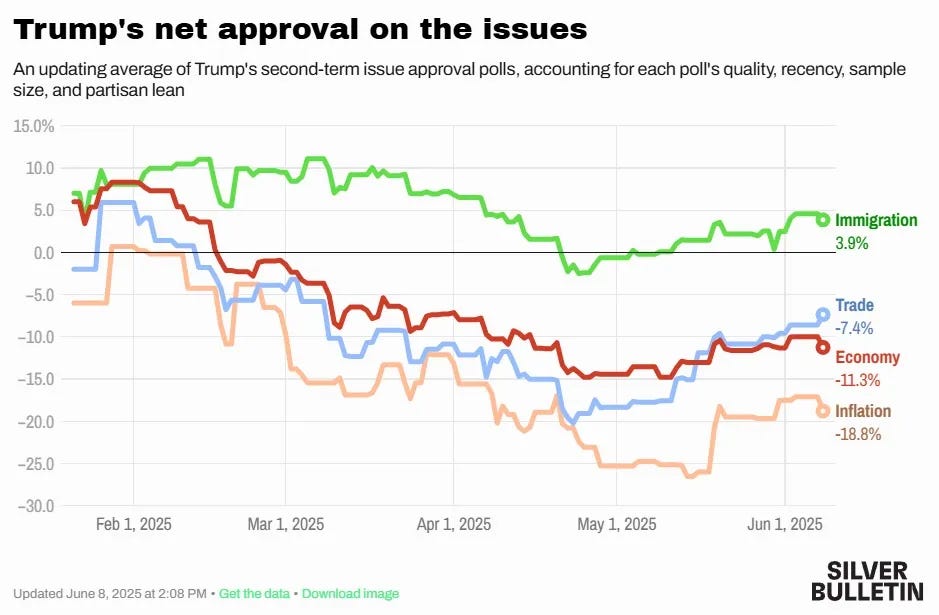How Democrats Can Win on Immigration
Turning a political liability into an asset.

Every Democrat knows that their party has an immigration problem. What few seem willing to admit is that immigration—more than inflation, more than crime, more than any other issue— has eroded the party’s brand. According to a recent Wall Street Journal poll, Democrats’ net favorability has cratered to its lowest point in 35 years. On immigration, voters now prefer Republicans by more than 20 points—even after years of Trump’s theatrics, ICE raids, and cruelty-as-policy.
Merely opposing Trump is not a strategy. Democrats need a vision that speaks to voters’ anxieties without surrendering their values. They need something they don’t currently have—a plan to win public support on immigration.
Recently, I spent several days in a prosperous nation that is deeply admired by American progressives for its generosity and happiness. It was odd to realize that its immigration policies are among the strictest in the Western world—and often harsher than Donald Trump’s.
Very restrictive asylum policies. This nation turns away nearly all asylum seekers. They confiscate jewelry from applicants to cover the costs of processing asylum claims. In 2021, the government seriously debated forcing asylum seekers to wait in Rwanda while the authorities adjudicated their applications.
Anti-ghetto campaigns. Since 2010, the government has surveyed every housing district with a majority of non-Western immigrants or their descendants. Districts with low employment, education, or income, or high crime are designated either “ghettos” or “tough ghettos”. Most neighborhoods on the “ghetto list” are heavily Islamic. “Ghetto parents” face reduced social benefits and harsher penalties if convicted of a crime. Authorities aggressively reduce social housing in ghetto neighborhoods by selling or demolishing entire blocks and forcing residents to relocate. One neighborhood in the capital city has forced more than half of its residents to relocate since 2020.1
Forced assimilation. Children of ghetto parents are required to attend 25 hours of cultural assimilation classes each week starting at age one. Here, the state teaches babies a new language, culture, and customs that often violate their parents' religious teachings. Parents may not attend.
Had I visited China, which routinely returns North Korean refugees to the gulag? Nope, I had been to Denmark – one of the happiest nations on earth and a country idolized by progressive Americans.
Why is Denmark, of all places, so deeply unwelcoming to immigrants?
Mette Friedriksen
Mette Frederiksen is Denmark’s youngest-ever Prime Minister. She blends progressive leadership on climate change, retirement, education, and defense with a ruthless immigration stance aimed at neutralizing right-wing populism. Her message: You can’t sustain generous social benefits without carefully managing immigration.
Fredriksen is a formidable politician. She was elected head of Denmark’s Social Democrats at the age of 38 and has served as Prime Minister since 2019. She led the enactment of Denmark’s Climate Act, which requires a 70% reduction in greenhouse gas emissions by 2030 and imposes high taxes on agricultural emissions. Friedriksen extended pensions to enable manual workers to retire earlier, strengthened vocational education, and led Denmark through the COVID-19 pandemic. When Russia invaded Ukraine, Friedriksen abandoned her EU skepticism, substantially increased Danish defense spending, and expanded military conscription to include women.
Friedriksen is determined to prevent the emergence of far-right political parties or the election of a Danish Viktor Orban or Donald Trump. She joins the Greens when it comes to taxes on burping cows, but on immigration, she has persuaded Social Democrats to adopt refugee policies commonly associated with the far-right.
Her case for doing this is that the cost of excess migration falls inevitably on Denmark’s poor. She knows that businesses are happy to hire low-cost Syrian construction workers, and well-off homeowners appreciate Turkish nannies. But she argues that working-class Danes in distant suburbs find their children in school with classmates who don’t speak their language and with Islamic cultural, religious, and gender norms that are anything but Danish. Friedriksen points to the crime-ridden immigrant ghettos outside Brussels, Paris, and Stockholm and argues that excess immigration challenges the cohesion that underpins Denmark’s famously generous social benefits.2
Danes approve. Under Friedriksen’s administration, Danish asylum applications are the lowest in 40 years.3 As right-wing anti-immigrant movements claimed working-class votes across Europe, the push by the Social Democrats to champion stricter immigration policies vaporized the Trumpish Danish People’s Party (DF), which had dominated far-right/nativist politics. DF's support collapsed from 21% of the vote in 2015 to less than 9% in 2019, as it lost voters to the Social Democrats.
When Friedriksen stood for re-election in November 2022, immigration was helping to topple progressive leaders throughout Europe and the US, but the Danish Social Democrats achieved their best results in twenty years. Social Democratic parties throughout Europe are taking notice. In the 1990s, these parties typically controlled 13 out of 15 nations in the European Union. Today, Denmark, Spain, and Germany are the only three European countries with social democratic heads of state.
Most Danes I spoke with viewed Friedriksen’s policies pragmatically. Comments like “You cannot implement progressive policies if you cannot win the support of people who are adversely affected by immigration” and “Social Democrats are, above all, democrats. We pursue policies that reflect mainstream public opinion and benefit working families” were common.
Democrats: Learn From Mette Friedriksen, But Don’t Copy Denmark
What should American progressives who value our liberal and pluralist heritage as a nation of immigrants take from this, especially in the face of Trump’s reckless, cruel, and occasionally lawless use of ICE?
Democrats should start by avoiding three of their worst habits: settling for mindless Trump resistance, confusing Trump’s falling popularity with political success, and trying to blindly copy Denmark. Fighting Trump is not enough. Democrats need a plan that can win popular support, even if Trump’s popularity is falling. Dems must advance a positive-sum view of immigration economics, politics, and culture that acknowledges the legitimate concerns of Americans who value their citizenship highly and dislike Biden’s reckless disregard for the integrity of American borders.
Dems should recognize that America is vastly better than Denmark at assimilating immigrants. After all, even our viciously anti-immigrant President is the son of an immigrant mother and has married two immigrant women.
Without turning hostile to immigration, Democrats can nonetheless learn a great deal from how Mette Friedriksen has thwarted right-wing political parties from using immigration to drive conservative economics, politics, and culture. Specifically, Democrats should notice how Friedriksen separated asylum claims from labor market immigration, took citizenship and border control seriously, and forced employers to curb illegal hiring.
Separate Asylum From Economic Immigration
Political asylum exists to protect individuals fleeing racial, religious, or political persecution. Mixing it with economic migration hurts legitimate asylum claimants who urgently need protection. It has all but destroyed the global asylum system, which Europe designed to deal with Soviet refugees in post-war Europe.
A world of proliferating conflict, climate-induced migration, cheap travel, ubiquitous information, and huge education and wage disparities has led nearly a billion people to consider permanent migration. Because most rich countries have closed their doors, it is now almost impossible for a citizen of a poor country to move legally to a rich one. So they move illegally, often using asylum as a back door. The US invites abuse by allowing claimants to enter the country and find work while officials adjudicate their asylum claims over many years.
Voters see a backlog of more than 1.6 million US asylum claims and conclude, correctly, that claimants are scamming the system. Fear of border chaos has given us Brexit, Trump, a rising and vicious right-wing populist movement in Europe, and the poisoned politics of legal migration.
The first step in untangling this mess is to distinguish between political and economic immigration. People displaced by war, disaster, or persecution have a right to seek safety, but not necessarily in a rich country’s labor market. Offering refugees sanctuary in the first safe neighboring country generates far less political opposition and makes an eventual return home far more likely as conditions change. For this reason, the EU has broadly welcomed Ukrainians, and Turkey has welcomed Syrians, but in recent years, the EU has not welcomed Syrians. Granting refuge in neighboring countries is also vastly cheaper, which makes it feasible to accommodate larger numbers and secure the financial support of wealthy countries. Finally, separating asylum claims deters smuggling, which thrives on the belief that anyone can gain entry to the US by claiming asylum.
Democrats should not be anti-asylum. They should promote asylum in adjacent countries and denounce asylum systems that invite abuse and render our borders porous.
Strengthen Border Control by Expanding E-Verify
Three weeks before his disastrous debate with Donald Trump, Joe Biden issued an executive order that belatedly closed the asylum loophole. Unauthorized border crossings dropped immediately and have remained low as Trump steps up his performative deportation raids against those who entered the country illegally. Trump’s new budget spends about $170 billion on border and immigration enforcement over four years.4
There is a far cheaper and less theatrical way to enforce immigration restrictions, however: strengthen and expand the E-Verify system to cover all jobs. At present, E-Verify is mandatory only for federal contractors. It is compulsory or encouraged in some states but remains optional for most other employers. According to a 2016 report by the US Department of Homeland Security, expanding the E-Verify system to make its use mandatory for all employers would cost $95-$214 million for four years, depending on whether existing employees would also need to be verified. Call it $300 million, some of which would be paid for by fines from enhanced enforcement. Adding 5,000 enforcement officers roughly doubles this cost. Strengthening E-Verify costs hundreds of millions, not hundreds of billions.
Other nations have demonstrated that digital verification systems can work effectively to control illegal immigration. The Right to Work system in the UK, the WPOL System in Singapore, and IND Checks in the Netherlands each work well because they combine digital/biometric verification, cover all employers, and carry out vigorous enforcement with routine audits and significant penalties. Each of these systems is backed by a clear legal framework that articulates obligations and encourages employer compliance. We know how to do this.
Democrats should advocate for expanding and strengthening E-Verify. They can point out not only Trump’s dangerous stormtrooper cosplay but his grotesque wastefulness, lack of seriousness, and unwillingness to hold employers accountable in their hiring practices. They can mention that in Denmark, employers can face massive fines and even prison time for repeatedly hiring unauthorized workers.
Introduce Point-Based and Regional Visas
Democrats should adopt Canada’s successful point-based immigration model. Applicants earn points based on clear, transparent criteria—skills, language, job offers—creating an immigration system that attracts talent and aligns directly with economic needs. A complementary regional visa program would allow states to sponsor workers where they’re most needed directly.
Immigration today relies heavily on family connections rather than specific criteria like language, occupational skills, education, and employment prospects. Canada’s Express Entry program and Australia’s SkillSelect are models that work well in countries that are similar in many respects to the US.
A point system establishes clear criteria and an online scoring calculator that awards points for qualifications that visa issuers can manage. These typically include educational degrees, professional credentials, or trade certifications, English language proficiency, job offers, industry demand for specific occupations, and work experience, particularly in high-need areas. Democrats should advocate for a “Skills for America Act,” with clearly defined criteria and quotas, and design it for broad, even bipartisan, appeal.
Democrats should also argue for allowing states to issue regional visas that permit states facing labor shortages or population declines to sponsor immigrant workers directly. Dems should support federal legislation authorizing a State-Sponsored Visa that enables states or state consortia to petition annually for a specific number of visas based on demonstrated economic needs or labor shortages.
States should be allowed discretion to select visa recipients, provided they meet federal standards. These visas require immigrants to live in specific geographic regions for 3-5 years. Once again, our neighbor to the north offers a helpful example. Canada’s Provincial Nominee Programs allow provinces to target local workforce shortages in fields like rural healthcare or Midwest agriculture.
Employers are always tempted to abuse visa programs to reduce wages. To prevent this, the US should require that visa holders be paid above the median wage or salary in each local market. The burden for demonstrating this should be on the employer, and should be subject to regular compliance audits. If visas are responding to genuine labor shortages, no employer has cause to object. This provision should apply equally to farmworkers and to AI engineers.
Accelerate Integration and Citizenship
We should expect every immigrant to not only work in the US legally but also to contribute as citizens. Democrats should advocate for measures that accelerate the economic and social integration of immigrant communities. A “Citizenship Integration Grant Program” could provide grants to cities or states that offer integration services, such as English language programs and civics classes, to prepare immigrants for the citizenship test. Dems should advocate for funding for local immigrant resource centers that provide education, vocational training, and civic classes that help immigrants pass their citizenship test.
To avoid pushing migrants into informal labor markets, Democrats should simplify and expedite naturalization processing. They can offer strong social incentives by lowering fees and expediting the applications of those who participate in public service, serve in the military, or complete civic integration programs.
Framing Immigration for Voters
Although Donald Trump’s policies are becoming less popular, immigration remains his strongest issue. Democrats simply do not have an option of being silent or stupid on the matter. And they would do well to remember that Barack Obama deported more than 3 million people for crossing into the country illegally – nearly all of them without court hearings. Trump is desperate to break his record.
Democrats must frame immigration as an issue of economic growth and national interest, not as a purely humanitarian concern. The message should highlight fairness, accountability, and mutual benefit rather than victimhood narratives or identity politics. They should support programs that provide built-in flexibility for states to adjust immigration criteria, quotas, and regional needs annually based on evolving labor market conditions.
Cultural extremists on both sides are driving the politics of immigration. When Trump says immigration is an invasion, leftists wave Mexican flags at pro-immigration rallies. When Trump declares protests an insurrection, some progressives demand that the public “strike back”.
Both sides are defying the common sense of the American public, which is generally favorable to immigration but strongly dislikes party-crashing. Americans want secure borders because control over who can enter any country is fundamental to national sovereignty. They recognize that the US has strong demographic and national security reasons to favor immigration. And the public does not want ICE agents strong-arming people in their community or arresting and deporting innocent people.
In short, America doesn’t need to copy Denmark’s harsh immigration tactics, but Democrats should take Frederiksen’s political realism to heart. Secure borders, carefully managed economic immigration, and accelerated assimilation are not conservative talking points—they’re progressive necessities. Trump has given Democrats a path forward. They need to take it.
Musical Coda
In 2021, “ghettos” were rebranded as “parallel societies”. Not sure that helps.
I doubt that Friedriksen quoted Milton Friedman, who famously asserted that "It's just obvious you can't have free immigration and a welfare state" — but she agrees with his thesis. Since Friedman spoke, economic research by conservative economists suggests that he was wrong. It may not be obvious, but most (but not all) immigrants to the US remain fiscal positives even with the welfare state.
Discussions of immigration policy like this are detached from the plight of refugees who risk their lives and savings to flee intolerable conditions at home. An Eritrean couple entitled their compelling account “The Road to Freedom Goes Through Hell”.
The budget includes more than $50 billion for border wall construction and maintenance, CBP checkpoints, and facilities, $45 billion for expanded detention facilities, and $15 billion for agents, vehicles, technology, and training.




P.S. A minor detail: Cattle farts don't release methane. 95%+ of cattle methane emissions are from burps.
One of the practical issues of E-Verify is that is does not distinguish between new employees and longstanding ones. With a large number of law-abiding, tax-paying workers in long-established jobs at many businesses, the E-Verify system can wreak havoc by disrupting workers well beyond entry level leading to potential losses at highly skilled positions and managerial levels. This is the source of most employers' resistance.